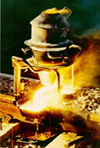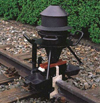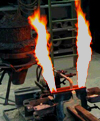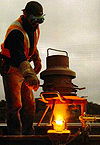The Goldschmidt Group

Founded in 1999, Goldschmidt Thermit GmbH is the holding company of over 20 medium-sized individual companies, which together form the Goldschmidt Group, and jointly operate the international market growth of rail transport infrastructure.
The Goldschmidt Group has been involved in over 100 years in the development of methods of rail welding (fusion welding) and in the repair of railroad tracks. Based on the pioneering invention of Prof. Hans Goldschmidt, the end of the 19th Century has the THERMIT ® process discovered and brought to industrial maturity, have been developed over the years a variety of methods, railroad rails to be welded together seamlessly. Here, the materials and processes are constantly increasing demands of the railway system and adapted. The increase of vehicle speed and axle loads, reducing maintenance costs and the reduction of road noise is still the outstanding goals. In addition, the group began at an early stage to deal with the rehabilitation of the rail network. These electric welding methods and modern grinding equipment is used.
Historical Outline

Prof.
Hans Goldschmidt
1861-1923
Erfinder des Thermit-
Schweißverfahrens
On March 13, 1895, the Goldschmidt business based in Essen, Germany, was granted German patent number 96317, Process for manufacturing metals and alloys. Prof. Hans Goldschmidt had managed to develop the reduction of metal oxides with aluminum powder to a technical standard by recognizing that the enormous heat resulting from the exothermic reaction can also be used for welding metal. After successfully welding tram rails at the beginning of the 20th century, the first railroad tracks were continuously welded for the German Reichsbahn in 1928.





Prior to the First World War, the Thermit® process began spreading worldwide through local representatives and national companies. Following the Second World War, the railway industry around the world used Thermit® welding to produce continuous tracks, giving Thermit® companies an enormous boost worldwide. With the founding of new companies and joint ventures, the international organization was systematically built up. Thermit® businesses are now established in: Italy (1950), India (1951), Brazil (1952), Austria (1952), England (1958), USA (1967), South Africa (1976), Australia (1986), Czech Republic (1993), Hungary (1995), and China (2004).
In 1999, the Thermit Group separated from its parent company, Th. Goldschmidt AG, and is now full owned by the Vermögensverwaltung Erben Dr. Karl Goldschmidt GmbH (VVG), headquartered in Essen, Germany. Two years later, in 2001, VVG also acquired the ELAUGEN Group to expand theirservice capabilities to maintain track infrastructure for railway companies.
Reorganization in 2005 resulted in the opening of a totally new central Thermit® manufacturing facility on their original site in Halle, Germany, and the merging of multiple European service providers into Goldschmidt Thermit Railservice GmbH. As a result, the companies belonging to the Goldschmidt Thermit Group arewell-equipped to meet the challenges faced by modern railway networks worldwide. Continualefforts to improve rail performance and services offered benefitrailway companies worldwide.
Through the development of the SmW rapid welding process in 1955, it was possible to markedly reduce the time required for Thermit® welding and increase its cost-effectiveness. A further development in 1972,the SkV rapid welding process, set the standard thatis used by the German Bundesbahn and many other railway companies around the world to weld their tracks. Continuous development has lead to the introduction of improved processes, including standard and wide gap joints, composite joints, and joints between Vignole, Tram (grooved), and heavy section crane rails.
In addition, electrical welding procedures allow Thermit companies to rebuildrail-head profiles and surface smoothness of worn tracks to increase their useful life and improve their performance. This is done on site usingsubmerged arc welding known as the ELLIRA process. It was further developed in accordance with the requirements of the railway companies to become the ETEKA 5 and RIFLEX welding processes. Special grinding devices for re-profiling the running surface were also developed.
The success of these techniques has led to the manufacture of new rails with these same techniques in order to substantially improve their running smoothness and resistance to wear and tear. Over the course of the years, the Thermit companies have not just focused on welding processes, but have also continually developed ancillary machines and equipment in support of rail maintenance. Examples include the hydraulic weld trimmer (1970), the automatic tapping thimble (1982) and the single-use EURO crucible (1998). In 1970, our MT insulated joint was launched onto the market.
In 2013, the PortaCo Inc./USA was acquired, a leading manufacturer of hydraulic power tools for the rail industry. In 2014, the Technology Innovation Center (TIC) in Leipzig opened, which provides services for all subsidiaries.
2016: Acquisition of SRS Sjölanders AB, Osby, Schweden, a leading manufacturer of two-way vehicle and opening of Goldschmidt Thermit Polska, Poland.

